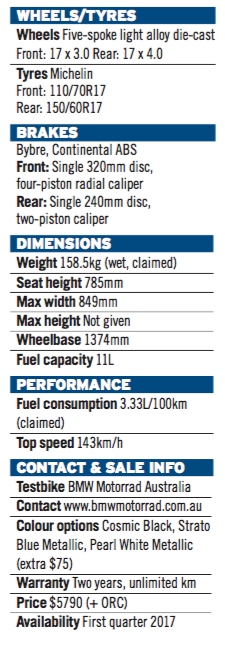BMW has unleashed its contender for the lucrative small bike market. Offering German engineering and top performance for just $5790 (+ ORC), the G310R promises to be a bestseller
BMW G310R- Sales of BMW motorcycles and scooters are riding at an all-time high, with 136,963 units delivered to customers around the world in 2015 – 11 per cent up on the previous year. Already in the first six months of 2016 the German manufacturer’s two-wheeled division has delivered 80,754 machines, a further 3 per cent up on the same period one year ago, as it ramps up annual sales to hit the self-set target of 200,000 units by 2020.
A key ingredient in driving this ongoing increase in demand for its products is attracting first-time customers who may then progress up the ownership ladder in terms of price and capacity. Enter the G310R, BMW’s debut model in the sub-500cc capacity segment, designed and developed in Germany but entirely manufactured in India by its partner TVS. It’s been positioned an entry-level bike at developed markets in Europe, Australia and Japan, and as a prestige model in developing markets such as Brazil and Southeast Asia. From 2017 onwards the G310R will also be sold in the USA and perhaps in India, where as a locally made product it’ll be free of the steep taxes affecting imported models there – though BMW ironically says it won’t start selling the bike locally until it has established a national motorcycle dealer network in India capable of giving the appropriate level of after-sales support. In any case, the intent is clear: to create a global leader in the small-capacity bike market.
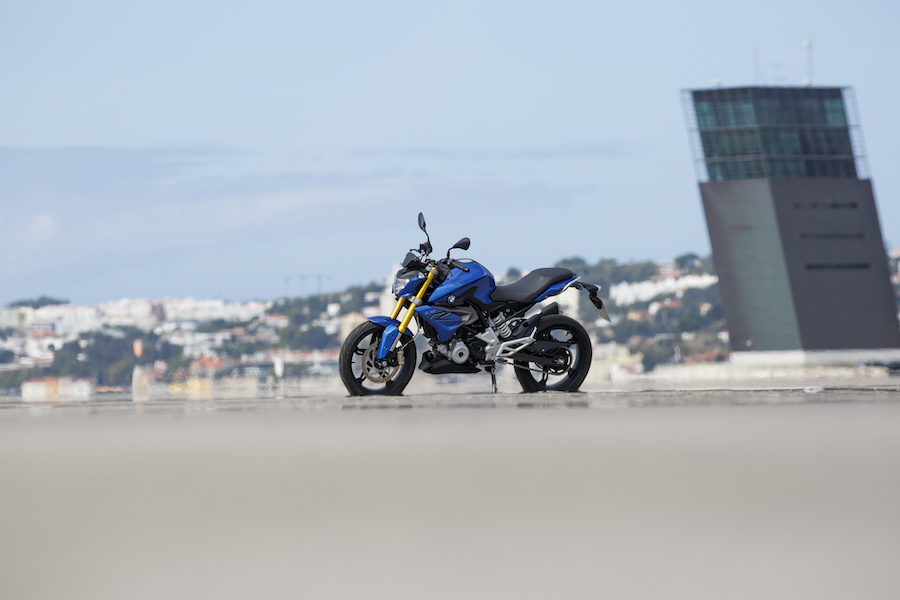
BMW G 310 R (K03)
TVS is India’s fourth-largest manufacturer (after Hero, Honda and Bajaj), whose three factories in India plus a fourth in Indonesia manufactured 2.15 million motorcycles in 2015. BMW signed a joint venture agreement back in April 2013 with the company owned by the Srinivasan family to manufacture the G310R, with development of the model starting that same year in Munich under the supervision of project leader Jürgen Stoffregen. It’s taken just three years to bring the all-new model to production – a timeframe that’s all the more impressive given that doing so entailed sourcing local suppliers capable of producing components to BMW’s standards, as well as educating TVS in German production values.
“Our key objective was very clear,” says Stoffregen. “We wanted to produce a real grown-up motorcycle, not a toy, but a properly sized bike with all the attributes and appearance of a normal motorcycle, which can accommodate riders of all heights. It must also be built to a level of quality in keeping with the customer’s expectations from BMW in terms of style, engineering, manufacturing quality and individuality. It was for us very important that this should be a true BMW, even though built in India by our partners TVS.”

BMW G 310 R (K03)
Achieving this level of manufacturing quality entailed a close collaboration with TVS, according to BMW Motorrad CEO Stephan Schaller. “We did the important part of the project in engineering and developing the bike in Germany to the stage that it was production ready,” he says. “But we also had many engineers from purchasing working with TVS in establishing a supply network in India to make sure that the standards of BMW are applied in sourcing components. We have something like 80 per cent of local content in the bike – but all components are made to German standards. I think our intensive search a couple of years ago to find the right partner gave us a very good result. They say that TVS stands for ‘trust, value and service’, and in my opinion this is a valid claim. It’s a third-generation family-owned company, with the owners working every day in the company. We are in very close contact with them, and admire the quality of their manufacturing process. They have the same long-term vision for this collaboration as we do at BMW, and I am very satisfied with the way they have adopted European standards for their manufacturing process in creating the G310R. TVS understands the BMW spirit.”
Owing nothing to any previous single in the company’s catalogue such as the G650GS, this new Indian-made world bike is a clean-sheet design by BMW engineers in Munich. But why 300cc? “We wanted to have more than 250cc, because when we started in this segment the Japanese firms like Kawasaki and Honda had a maximum capacity of 250cc,” says Stoffregen. “We decided that 300cc was likely to be the next step for them, so we decided to go with that capacity even though we had no competitor at that stage with such a model. I was quite pleased when Honda came out with the CBR300R! But we have no plans to make different capacity versions like a 200cc or 250cc variant using the same bottom-end design. At the moment this is not even under discussion, because it’s a lot of work to launch this model and bring it to market in a new segment for BMW, so we are concentrating all our efforts on this capacity platform.”
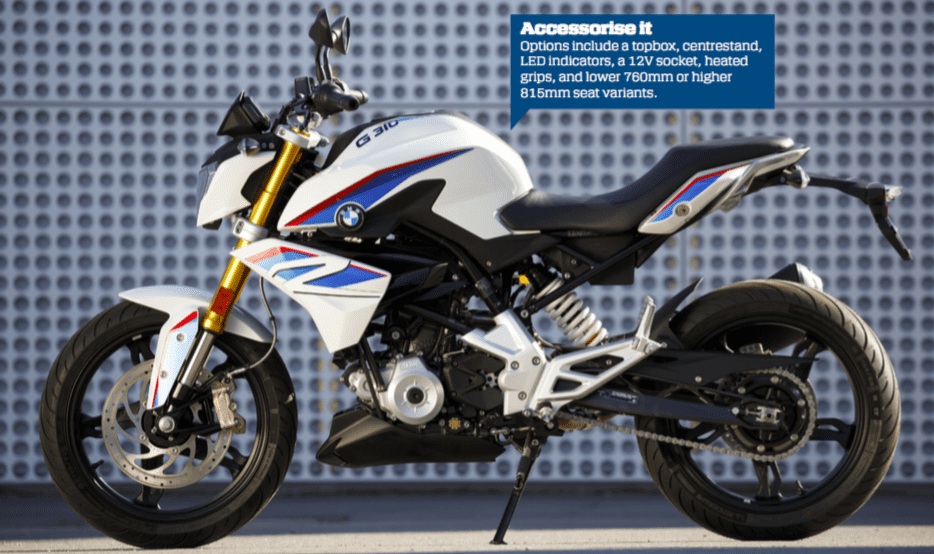
This learner friendly roadster will cost $5790 (+ ORC) in Australia and will be available in three colours: blue, black and BMW’s trademark pearlescent Motorsport hue (which costs a little extra). As with all BMW platforms, the G310R is merely the first roll of the dice for the German manufacturer, with Stephan Schaller admitting to ‘at least three’ different variants under development of the company’s new Indian-built single-cylinder platform. G310GS, anyone?
I joined a select group of 30 journalists at BMW’s home city of Munich for an advance ride on the G310R, and it delivered much more than just an hour or two of running round the streets of the city with a brief venture out into the surrounding countryside. Instead, the 220km route took us south of Munich into the foothills of the Bavarian Alps, where we encountered a broad range of riding conditions. There was even a brief spell of freeway travel when the homologated top speed of 143kmh showed up on the BMW’s digital Conti dash, with the tacho reading just nudging the five-digit segment as the small shifter light started flashing. Yet at that engine speed and all others the 313cc single motor felt completely unstressed and, more to the point, totally vibe-free – the single counterbalancer does its job to perfection.
Just seeing the G310R awaiting me in the courtyard of BMW’s Classic HQ elicited a quite different reaction than seeing it indoors in a showroom or show. Especially in the Motosport livery, it has a real sense of substance, a classy presence that conveys a different first impression than its brasher-looking European rival that’s also made in India, the lighter, bigger-engined and ever so slightly more powerful KTM 390 Duke. The whole bike exudes a visual level of quality that’s frankly unexpected in such a low cost product manufactured offshore. Only the plastic switchgear looks cut-price – the rest of the G310R components are pure BMW, with high quality alloy castings and forged triple clamps, an LED tail light, and an exceptionally lustrous paint job. On this early production model at least, build quality looks good. This is an inexpensive BMW, not a cheap one.
Those favourable first impressions continue as I hop aboard the relatively comfortable 785mm high seat, and find plenty of space for a 1.80m rider, with my knees tucked in nicely to the indentations in the plastic shroud housing the 11-litre steel fuel tank beneath it. The seat still needs a little more padding just where it meets the tank to be properly comfortable in a full day’s ride, though.
Thumb the starter button, and the engine catches instantly from cold on the auto-choke, then settles to a quite high 1500rpm idle – perhaps chosen to rule out any rear wheel chatter on the overrun in the absence of a slipper clutch. The large exhaust canister containing the Euro 4-compliant catalyst whispers rather than booms, though above 5000rpm there’s a pleasant rasp from the intake which gives you the impression you’re going somewhere.
As indeed you will, by short-shifting through the six-speed gearbox which has a light, precise action and invites you to keep the engine on the boil via your left foot. The oil-bath clutch is light and untiring, making riding the BMW in city streets a pleasure – your hand won’t cramp up, although bottom gear is very low and obviously chosen for when a passenger is carried (make that plural in India!). You soon find it’s better to start from a stop on level ground in second gear if you’re on your own, without any need to slip the clutch unduly. But shifting gear is really a delight, and though you must use the clutch for the bottom two upward shifts to do so smoothly every time, you don’t need to do so in the higher ratios. Indeed, so precise and clean is the shift action, you can also drop from top gear to fifth without using the clutch.
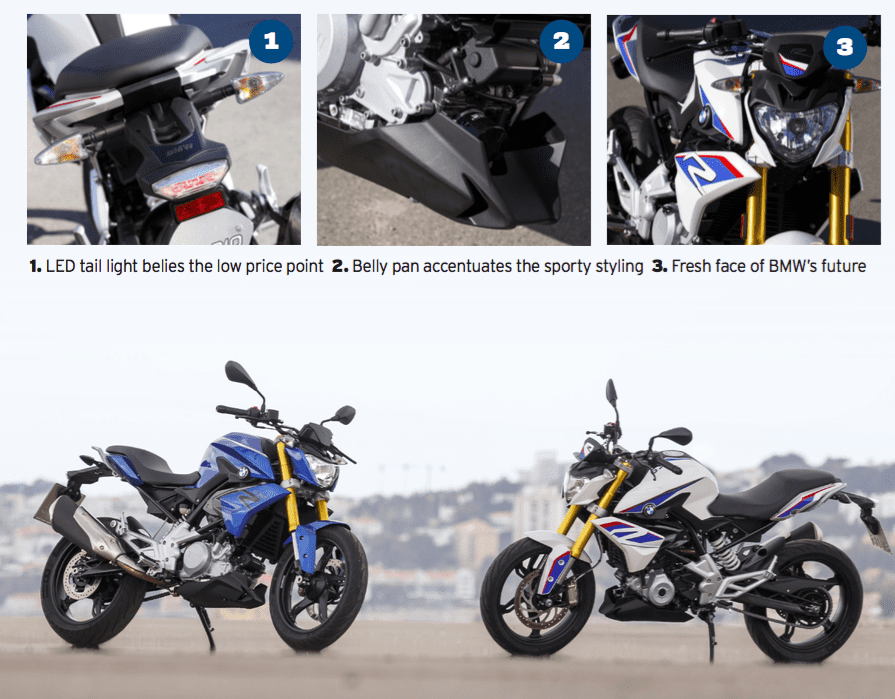
The G310R is a great traffic tool, thanks partly to the wide spread of torque peaking at 7500 revs, just three-quarters of the way to the 10,500 rpm revlimiter. The 310cc twin-cam single pulls wide open in top gear from as low as 3200rpm without any hesitation or transmission snatch, owing to its good low-down fuelling. Then there’s an extra kick of acceleration around 7000rpm, and another one at nine grand, so it pays to rev it out. That’s not to say that the power delivery is layered, just that it becomes more urgent the harder you rev the motor. Nice.
The G310R’s tubular steel frame more than lives up to the job of harnessing this power delivery, and the non-adjustable Kayaba suspension plays a key role in this. Its fixed settings at both ends are extremely well chosen, with much better compliance than you have any right to expect for such budget hardware. Ride quality is high, especially at the rear, and the damping so well chosen that I ended up looking for the rare patches of rough tarmac on German B roads to give it a workout. Compression damping on the fork could possibly be a little stiffer, because when you lean on the front brake for maximum stopping power there is some nose dive, but it’s not excessive. The single front 300mm disc and its four-piston radial caliper are just about up to the job of hauling down the BMW and a solo rider quickly from speed, but you must use the rear brake hard as well for panic stops, and you don’t get the feeling there’s much in reserve. It’s exactly the same brake package as on the KTM 390 Duke, where I think it works a little better. Pads, maybe?
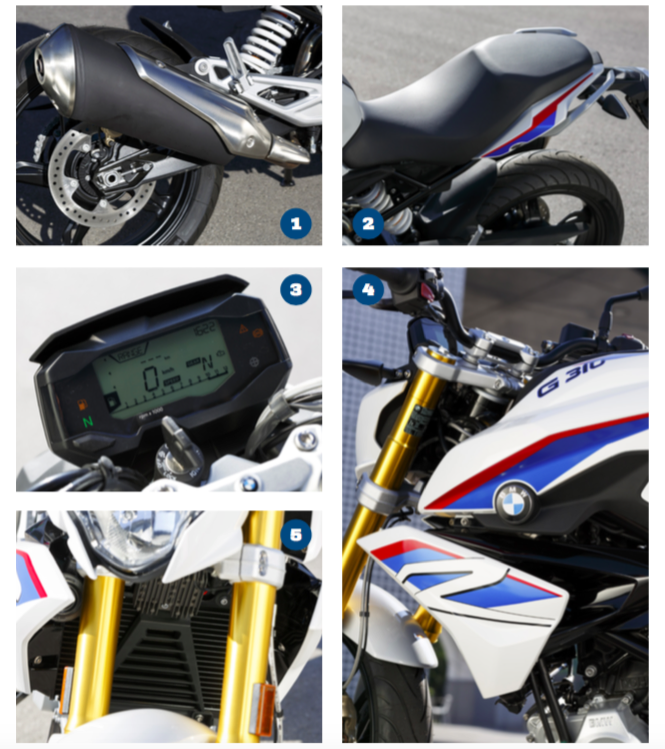
1. Exhaust goes softly softly to meet Euro4 standards 2. Dual seat is stepped for the passenger, but there’s no room beneath it for an anti-theft locking device 3. Continental LCD dash includes rpm, speed, gear selected, odo plus twin trips, engine temperature, fuel level and range, average fuel consumption, average speed and a clock 4. The non-adjustable 41mm fork is sourced from Kayaba’s factory in China 5. Minimal front mudguard means radiator needs extra protection
The BMW feels planted in a straight line – it gives no impression of being a skitzy lightweight package, in spite of which it changes direction very easily, aided by the good leverage from the handlebar. My only criticism is that there wasn’t much feedback from the front Michelin tyre, which gripped okay at the speeds I was prepared to trust it at leaned over in turns, but seemed to have an unduly stiff structure for a small, lightweight bike like this. Apparently BMW has also homologated Metzeler tyres for the G310R, and I’d like to try it again with these fitted – I suspect their lighter construction would deliver better feel and thus increased turn speed from the front end.
No doubt about it, BMW and TVS have joined forces to produce a motorcycle that’s self-evidently a BMW, but made in India largely to the standards of its Berlin factory. There’s an honest sense of manufacturing quality about the G310R, coupled with dynamic refinement in use – the engine is beautifully fuelled, seems strong for its capacity level, and feels unburstable. While keenly priced, it conforms to BMW’s brand identity in terms of performance, manufacturing quality, and styling. Its rivals such as KTM’s 390 Duke, Kawasaki’s Z300, Honda’s CBR300R and Yamaha’s MT-03 – oh, and not forgetting the Chinese-made Benelli BN302 – have all got trouble on their hands.
TEST ALAN CATHCART PHOTOGRAPHY BMW MOTORRAD

